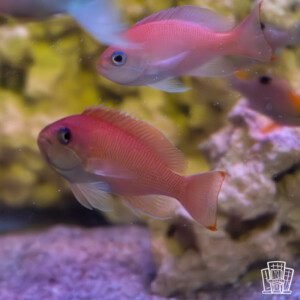Description
Scientific Name: Labroides dimidiatus
Common Names: Bluestreak Cleaner Wrasse, Common Cleaner Wrasse
Maximum Length: 5.5 inches (14 cm)
Minimum Aquarium Size: 55 gallons (208 liters) for a single fish; larger tanks (75 gallons or more) are better for providing ample swimming space and hiding spots. Their active nature appreciates room to move.
Foods and Feeding Habits: Carnivorous, specializing in eating parasites and dead skin off other fish in the wild. From FisHotel, they will accept frozen mysis shrimp, brine shrimp, or finely chopped seafood. Feed small amounts 2-3 times daily, supplementing with live foods like copepods if they’re reluctant to eat.
Reef Safety: Reef-safe; they don’t harm corals or most invertebrates, focusing instead on cleaning other fish. They’re a great addition to reef tanks with compatible tankmates.
Temperament: Peaceful but active, these wrasses are social and spend their days “cleaning” other fish, removing parasites and imperfections. They’re generally non-aggressive but may chase smaller fish if hungry. Best paired with larger, semi-aggressive tankmates like tangs or angelfish that tolerate their cleaning behavior.
Description: The Bluestreak Cleaner Wrasse is a fascinating addition to marine tanks, known for its vibrant look and unique role. Its sleek body, marked by a bold blue stripe running from snout to tail against a black and yellow backdrop, makes it easy to spot. Native to Indo-Pacific reefs, from East Africa to the Great Barrier Reef, they thrive in tanks with live rock for cover and strong water flow. Their desire for client fish is fun to watch, and most fish appreciate the service. It brings lively behavior, and the cleaning antics give your tank that extra special dynamic.
Fun Facts:
Cleaner wrasses set up “cleaning stations” in the wild, where other fish line up for their parasite-removal services, like an underwater spa.
Their bright blue stripe isn’t just for show—it signals their cleaning role to other fish, helping them avoid predation.
They perform a distinctive “dance” with side-to-side movements to attract clients, a behavior you might catch in a well-settled tank.




